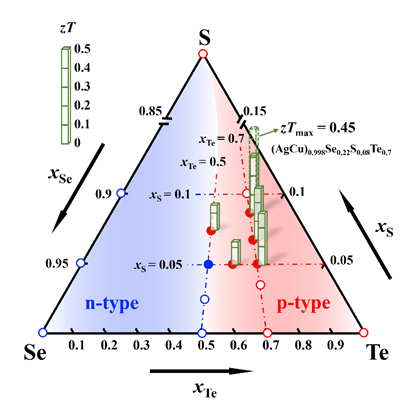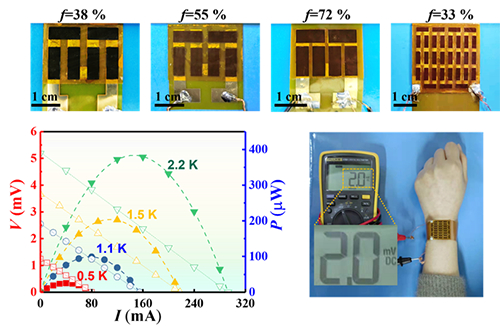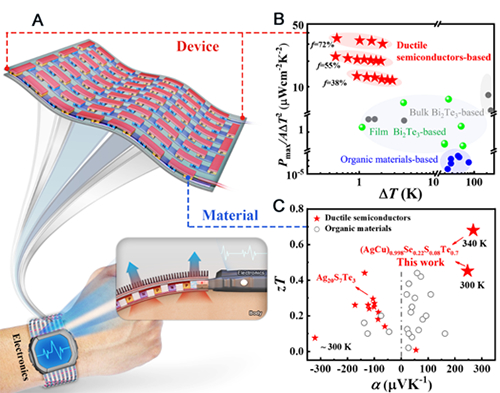Supported by the National Natural Science Foundation of China (Grant No. 91963208, 51625205) and other projects, Xun Shi and Lidong Chen’s group, Zhen Zhang’s group, and cooperators have achieved progress in flexible thermoelectrics based on ductile semiconductors. The research result was published in Science on August 19, 2022, with thetitle of "Flexible thermoelectrics based on ductile semiconductors". Website Link: http://doi.org/10.1126/science.abq0682.
Flexible thermoelectric (TE) generators, with the advantages of small volume, no moving parts, all-weather continuous working, and high reliability, can directly convert the heat from human body to electricity and provide a promising self-power supply solution to wearable electronics. Currently, there are three typical approaches to fabricating flexible thermoelectrics. The first approach is depositing classic brittle inorganic thin film TE materials such as Bi2Te3-based alloys on flexible substrates or scaffolds. The second approach is directly using flexible organic TE materials. However, the flexible TE devices fabricated by these two approaches usually demonstrate low output power density due to the material’s poor figure-of-merit (zT) and the device’s integration technology. The recent discovery of Ag2S-based ductile semiconductors by the research team provides a third approach to fabricating flexible thermoelectrics because of their excellent metal-like machinability. However, flexible TE devices with conventional π-shape structure have not yet been demonstrated due to the lack of good p-type ductile TE materials.
Generally, Ag-contained compounds are n-type, while Cu-contained ones are p-type; high S content or high Ag content is prone to obtaining ductile materials while high Se and Te contents or high Cu content are prone to obtaining brittle materials. In this work, the research team particularly focused on AgCu(Se,S,Te) pseudo-ternary solid solutions in an attempt to find high-performance p-type ductile TE materials. Via plotting the composition-performance phase diagram, the “p-n” and ‘brittle-ductile’ boundaries were determined (Figure 1). Both good ductility and p-type conduction were observed in AgCu(Se1-y-xSxTey) withx between 0.05-0.08 and y between 0.5-0.7. AgCuSe0.3-xSxTe0.7(x = 0.06and 0.08) and the cation-deficient derivates showed the zT of 0.45 at 300 K and 0.68 at 340 K, record-high values in flexible TE materials. Based on these p-type ductile TE materials, the world’s thinnest (0.3 mm thick) flexible p-shape TE devices were successfully developed with a maximum normalized power density up to 30 mWcm-2K-2(Figure 2), about four times the Bi2Te3-based TE devices, at least four orders of magnitude higher than the organic-based flexible TE devicesandone order of magnitude higher than other low-grade heat-to-electricity conversion technologies(Figure 3).
These studies provide a novel strategy for high-performance flexible thermoelectrics, which can directly and efficiently convert the low-grade heat energy such as the heat from human body to useful and sustainable electricity, offering a promising self-power supply technology to wearable electronics for real applications.

Figure 1 Composition-performance phase diagram of AgCuSe-AgCuS-AgCuTe pseudo-ternary solid solutions.

Figure 2 Optical images and output performance of flexible TE devices.

Figure 3 Schematics and performance of flexible TE materials and devices.

Add: 83 Shuangqing Rd., Haidian District, Beijing, China
Postcode: 100085
Tel: 86-10-62327001
Fax: 86-10-62327004
E-mail: bic@donnasnhdiary.org
京ICP备05002826号 文保网安备1101080035号 Copyright 2017 NSFC, All Right Reserved